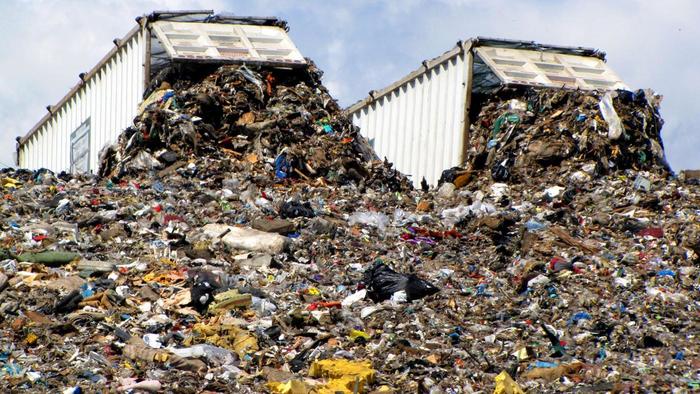Source: blog.laddawn.com
Published: July 26, 2016
A common misconception is that plastics are the number one component of landfills and the fastest growing segment. That’s not true.
Because modern packaging cannot be eliminated from the shipment and storage of most products, environmental awareness ultimately spotlights our choices about how we use packaging. For Instance, California’s ban on plastic shopping bags has generated a lot of interest from our partners on the west coast. But regardless of where you distribute bags and film, you’ll find customers looking for simple and honest responses to concerns about the role of plastics in the waste stream. And while it isn’t a glamorous place to look, many of the best answers are found in your local landfill.

Hey, I think I see that bag of chips I had last weekend.
The Make Up Of A Landfill
Located, designed, operated and monitored according to local, state and federal regulations, today’s landfills are well-engineered facilities. For human health, environmental and economic reasons, the science of managing landfills has become a serious issue. Each year, over 200 million tons of trash finds its way from American households to landfills. It’s called Municipal Solid Waste or MSW and it includes everything except construction debris and industrial waste.
In landfills, trash is compacted and covered with dirt to keep odors down, stop the spread of bacteria and discourage scavengers. Rainwater becomes polluted as it mingles with a landfill’s pesticides, inks and household hazardous waste. So, to protect surrounding areas, modern landfills are lined with gravel, clay and plastic. Leachate (contaminated water) is piped into treatment facilities.
A common misconception is that plastics are the number one component of landfills and the fastest growing segment. That’s not true. In fact, it’s not even close. A recent report by the U.S.EPA showed that plastics make up about 12.7% of our municipal solid waste stream – nearly half that of paper and cardboard. Other resources for “ecofriendly products” estimate that if plastic were replaced by comparable materials, trash weight would climb by 150%, packaging would weigh 300% more and the energy consumed to manufacture viable alternatives would increase by 100%.
Landfill Biodegradation
Over 2/3’s of the garbage going into landfills is theoretically biodegradable. But in reality, relatively little decomposition ever takes place. Even paper, the number one constituent of landfills at 35.7% by weight, degrades at an impractically slow rate. A newspaper from 1950 might smell too musty for your coffee table, but you’ll find it to be completely readable. Biodegradation happens when organic materials are exposed over time to the proper amounts of micro organisms, moisture, oxygen and heat. Unlike compost piles, where organic materials are cut up, stirred and kept moist, waste entering landfills is condensed and entombed. Where biodegrading requires 65% moisture, landfill waste typically contains only about 25-30%. So, like any other organic material, paper is resistant to deterioration once compacted in a landfill.
Biodegradable Plastics
The same things that make plastics valuable (strength and durability) also makes them non-biodegradable. So, in recent years, we’ve begun to see the emergence of biodegradable plastic technologies. Researchers have created biodegradable plastics by combining the physical performance of plastic polymers with naturally occurring polymers like starch – something microorganisms can readily eat away. Two primary questions remain:
One – How much will it degrade? To maintain product integrity, biodegradable additives are typically added at concentrations of around 5%. The plastic products that result will merely degrade into smaller pieces of plastic. The bag or bottle might be gone, but the plastic will still be there. Moreover, the same principles that limit biodegradation of paper in landfills will limit plastic biodegradation.
Two – How much will it cost? In a 2004 consumer survey, roughly 70% of respondents said they’d buy recycled plastic only if the cost was the same. About 25% were in favor of recycled plastic at a modest increase in price.
The re-melting process even sterilizes plastics for use in medical grade products. For manufacturers of products like flexible films and bags, an increased availability of quality recycled resins will enable new efficiency and economy. As a country we are recycling and reusing more. In 2000, the USA EPA reported that over 55 million tons of waste was “source reduced”, up from just over 1/2 million tons in 1992.
Integrated Solutions and the Future
The future will likely include three integrated solutions, which you have certainly heard of already. The EPA calls them “Reduce, Reuse, Recycle.” Overall, it’s called source reduction and it helps in 3 big ways. The production of fewer and lighter materials means less disposal, requires less energy, and generates less pollution and greenhouse gases. Most plastics can be re-melted and re-formed many times before they become brittle. And reclaimed plastics are almost infinitely useful.
Today, we recycle about 27% of the materials that can be recycled. Still, given the economics of recycling, the American Plastics Council contends that we will level off at about 33%. That means that 2/3’s will still end up in the waste stream.
